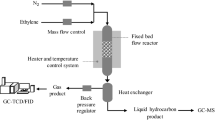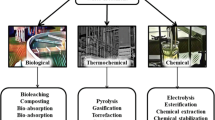Abstract
In this paper, hydroxyl-terminated polybutadiene (HTPB)/ammonium perchlorate (AP) and HTPB/cyclotetramethylene tetranitramine (HMX) mixtures with low content of oxidizer were prepared, and the thermal decomposition process of these mixtures was investigated with TG-FTIR and Raman spectrum. The experimental results indicated that during the thermal decomposition process under an inert atmosphere, HTPB and the two oxidizers could both decompose into gaseous products completely, while the mixture of HTPB and the two oxidizers produced some solid residue with carbon as the main ingredient; unlike the thermal decomposition of HTPB under argon atmosphere, HTPB cannot decompose completely under air or oxygen atmosphere, and the more the concentration of oxygen, the more the solid residue produced. Decreasing the content of oxidizer reacting with HTPB may improve the combustion performance of fuel-rich propellants by increasing the combustion temperature and the percentage of gaseous products. The results of this paper can provide the useful information for improving the combustion performance of fuel-rich propellants.









Similar content being viewed by others
References
Kuo KK, Summerfield M. Fundamentals of solid-propellant combustion. New York: American Institute of Aeronautics and Astronautics; 1984.
Cai WD, Thakre P, Yang V. A model of Ap/Htpb composite propellant combustion in rocket-motor environments. Combust Sci Technol. 2008;180(12):2143–69. doi:10.1080/00102200802414915.
Chen JK, Brill TB. Chemistry and kinetics of hydroxyl-terminated polybutadiene (Htpb) and diisocyanate Htpb polymers during slow decomposition and combustion-like conditions. Combust Flame. 1991;87(3–4):217–32. doi:10.1016/0010-2180(91)90109-O.
Du TF. Thermal-decomposition studies of solid-propellant binder Htpb. Thermochim Acta. 1989;138(2):189–97.
Bircumshaw LL, Newman BH. The thermal decomposition of ammonium perchlorate.2. the kinetics of the decomposition, the effect of particle size, and discussion of results. Proc R Soc Lon Ser-A. 1955;227(1169):228–41. doi:10.1098/rspa.1955.0006.
Bircumshaw LL, Phillips TR. The kinetics of the thermal decomposition of ammonium perchlorate. J Chem Soc. 1957;. doi:10.1039/Jr9570004741.
Boldyrev VV. Thermal decomposition of ammonium perchlorate. Thermochim Acta. 2006;443(1):1–36. doi:10.1016/j.tca.2005.11.038.
Menke K, Eisele S. Rocket propellants with reduced smoke and high burning rates. Propell Explos Pyrot. 1997;22(3):112–9. doi:10.1002/prep.19970220304.
Liu L-L, He G-Q, Wang Y-H. Thermal reaction characteristics of the boron used in the fuel-rich propellant. J Therm Anal Calorim. 2013;114(3):1057–68.
Kaser F, Bohn MA. Decomposition in HTPB bonded HMX followed by heat generation rate and chemiluminescence. J Therm Anal Calorim. 2009;96(3):687–95. doi:10.1007/s10973-009-0031-6.
Rocco JAFF, Lima JES, Frutuoso AG, Iha K, Ionashiro M, Matos JR, et al. Thermal degradation of a composite solid propellant examined by DSC—kinetic study. J Therm Anal Calorim. 2004;75(2):551–7. doi:10.1023/B:Jtan.0000027145.14854.F0.
Vyazovkin S, Wight CA. Kinetics of thermal decomposition of cubic ammonium perchlorate. Chem Mater. 1999;11(11):3386–93. doi:10.1021/Cm9904382.
Li X, Liu X, Cheng Y, Li Y, Mei X. Thermal decomposition properties of double-base propellant and ammonium perchlorate. J Therm Anal Calorim. 2014;115(1):887–94.
Zhu Y-L, Huang H, Ren H, Jiao Q-J. Kinetics of thermal decomposition of ammonium perchlorate by TG/DSC-MS-FTIR. J Energ Mater. 2014;32(1):16–26.
Liu LL, He GQ, Wang YH. Effect of oxidizer on the combustion performance of boron-based fuel-rich propellant. J Propul Power. 2014;30(2):285–9. doi:10.2514/1.B34909.
Liu LL, He GQ, Wang YH, Liu PJ. Factors affecting the measurement of the percentage of gaseous products from boron-based fuel-rich propellants. Cent Eur J Energ Mat. 2014;11(1):15–29.
Author information
Authors and Affiliations
Corresponding author
Rights and permissions
About this article
Cite this article
Wang, Yh., Liu, Ll., Xiao, Ly. et al. Thermal decomposition of HTPB/AP and HTPB/HMX mixtures with low content of oxidizer. J Therm Anal Calorim 119, 1673–1678 (2015). https://doi.org/10.1007/s10973-014-4324-z
Received:
Accepted:
Published:
Issue Date:
DOI: https://doi.org/10.1007/s10973-014-4324-z




